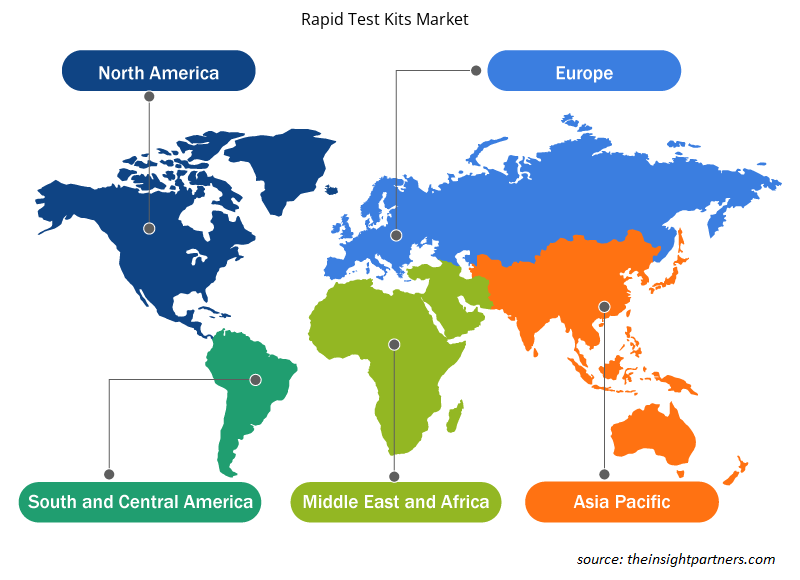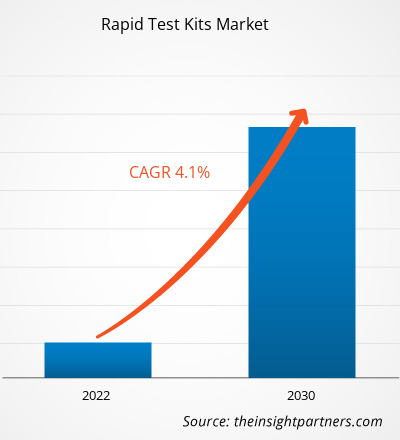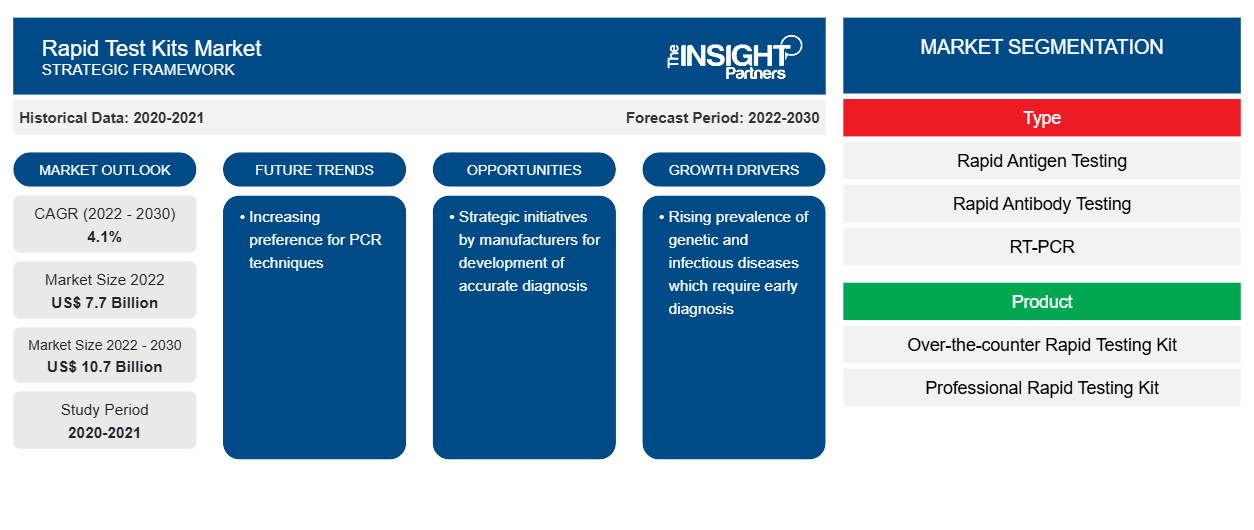من المتوقع أن ينمو حجم سوق أدوات الاختبار السريع من 7.7 مليار دولار أمريكي في عام 2022 إلى 10.7 مليار دولار أمريكي بحلول عام 2030؛ ومن المتوقع أن يسجل معدل نمو سنوي مركب بنسبة 4.1٪ خلال الفترة 2022-2030. ومن المرجح أن يظل الابتكار في اختبارات المستضدات السريعة اتجاهًا رئيسيًا في السوق.
تحليل سوق أدوات الاختبار السريع
إن توسيع مرافق الاختبار في مؤسسات الرعاية الصحية، وزيادة الوعي بأهمية التشخيص المبكر للأمراض والعلاج السريع للسيطرة على المرض، وزيادة الوعي بالاختبارات الجينية بسبب انتشار هذه الأمراض، وزيادة انتشار الأمراض المعدية مثل التهاب الكبد وفيروس نقص المناعة البشرية والملاريا، تعمل على تغذية نمو سوق أدوات الاختبار السريع . بالإضافة إلى ذلك، فإن المبادرات الحكومية لتعزيز الاختبارات التشخيصية السريعة للسيطرة على الأمراض والوقاية منها، وزيادة الاستثمار في أنشطة البحث والتطوير لتطوير اختبارات سريعة مبتكرة، وزيادة اعتماد أدوات الاختبار السريع في البلدان النامية تعمل على تغذية نمو حصة السوق.
نظرة عامة على سوق أدوات الاختبار السريع
من الناحية الجغرافية، من المتوقع أن تسجل منطقة آسيا والمحيط الهادئ أعلى معدل نمو سنوي مركب في الفترة المتوقعة 2023-2031. إن التركيز المتزايد على اللاعبين في السوق في تقديم مجموعات الاختبار السريع المتطورة تقنيًا لمختلف الأمراض يغذي نمو السوق. على سبيل المثال، في يونيو 2021، مُنحت شركة Kaneka Corporation الإذن بإنتاج وبيع Kaneka Immunochromatography SARS-CoV-2 Ag، وهي مجموعة اختبار للكشف عن مستضد COVID-19 . يمكن لمجموعة KANEKA RT-PCR SARS-CoV-2 (Omicron / Delta) الإصدار 2 تحديد العديد من المتغيرات في وقت واحد. بعد الموافقة عليها من قبل المجلس الهندي للبحوث الطبية في عام 2021، تم إطلاق مجموعة الاختبار الذاتي لـ COVID-19 المسماة CoviSelf تجاريًا في جميع أنحاء البلاد، والتي كانت المرة الأولى التي يمكن فيها لمواطن هندي إجراء الاختبار بنفسه في المنزل.
قم بتخصيص هذا التقرير ليناسب متطلباتك
ستحصل على تخصيص لأي تقرير - مجانًا - بما في ذلك أجزاء من هذا التقرير، أو تحليل على مستوى الدولة، وحزمة بيانات Excel، بالإضافة إلى الاستفادة من العروض والخصومات الرائعة للشركات الناشئة والجامعات
-
احصل على أهم اتجاهات السوق الرئيسية لهذا التقرير.ستتضمن هذه العينة المجانية تحليلاً للبيانات، بدءًا من اتجاهات السوق وحتى التقديرات والتوقعات.
محركات وفرص سوق أدوات الاختبار السريع
المبادرات الاستراتيجية التي يتخذها المصنعون لصالح السوق
يؤكد مصنعو أدوات الاختبار السريع على تبني استراتيجيات مثل ابتكار المنتجات وإطلاق المنتجات والموافقات للحفاظ على ميزة تنافسية في السوق. بالإضافة إلى ذلك، يشارك كبار اللاعبين في السوق في أنشطة البحث والتطوير لضمان ابتكار وتطوير منتجات فعالة. على سبيل المثال، في يناير 2022، أطلقت شركة OraSure Technologies، Inc.، وهي شركة عالمية رائدة في اختبارات التشخيص في نقطة الرعاية والمنزل بالإضافة إلى تقنيات جمع العينات، اختبار OraQuick HIV Self-Test، وهو اختبار منزلي قائم على مسحة فموية لفيروس نقص المناعة البشرية من النوع 1 وفيروس نقص المناعة البشرية من النوع 2، للسوق الأوروبية. يتوفر الاختبار في ست دول أوروبية: المملكة المتحدة وفرنسا وألمانيا وإيطاليا وإسبانيا والبرتغال. وبالتالي، فإن الزيادة في تطوير المنتجات وإطلاقها والتعاون الاستراتيجي بين اللاعبين في السوق تعمل على تغذية نمو سوق أدوات الاختبار السريع.
إن التفضيل المتزايد لتقنيات تفاعل البوليميراز المتسلسل يشكل فرصة لنمو السوق
في السنوات الأخيرة، تطورت الأساليب الجزيئية مثل تفاعل البوليميراز المتسلسل كأدوات تشخيصية أكثر فعالية، حيث تساعد في التشخيص الدقيق لمجموعة واسعة من الأمراض المعدية . تستخدم معظم الاختبارات الجزيئية الشائعة تفاعل البوليميراز المتسلسل العكسي (RT-PCR). توفر هذه التقنية نتائج قابلة للتكرار وقابلة للمقارنة بين المختبرات المختلفة وبالتالي يتم قبولها في جميع أنحاء العالم. يشارك المصنعون في تطويرات تفاعل البوليميراز المتسلسل الجديدة. على سبيل المثال، GeneSoC هو نظام تم تطويره مؤخرًا حيث يتم دفع حلول تفاعل البوليميراز المتسلسل بشكل متبادل عبر العديد من المناطق المسخنة مسبقًا وتغليفها على شريحة داخل قناة تدفق رفيعة للغاية. وبالتالي، من المتوقع أن يوفر التفضيل المتزايد لتفاعل البوليميراز المتسلسل كأداة تشخيصية وإكلينيكية فرصًا مربحة لسوق مجموعات الاختبار السريع خلال فترة التنبؤ.
تقرير تحليل تجزئة سوق أدوات الاختبار السريع
إن القطاعات الرئيسية التي ساهمت في اشتقاق تحليل سوق أدوات الاختبار السريع هي النوع والمنتج والتكنولوجيا والتطبيق والمستخدم النهائي.
- وفقًا للنوع، ينقسم سوق أدوات الاختبار السريع إلى اختبار المستضد السريع واختبار الأجسام المضادة السريع وغيرها. احتل قطاع اختبار المستضد السريع الحصة الأكبر في السوق في عام 2022.
- من حيث المنتج، ينقسم السوق إلى مجموعة اختبار سريع متاحة دون وصفة طبية ومجموعة اختبار سريع احترافية. احتل قطاع مجموعة الاختبار السريع المتاحة دون وصفة طبية حصة كبيرة من السوق في عام 2022.
- استنادًا إلى التكنولوجيا، ينقسم سوق مجموعات الاختبار السريع إلى اختبار التدفق الجانبي، والطور الصلب، والتكتل، واختبار البقعة المناعية، والمكون الخلوي. احتل قطاع اختبار التدفق الجانبي أكبر حصة في السوق في عام 2022.
- بناءً على التطبيق، ينقسم سوق أدوات الاختبار السريع إلى اختبار نسبة الجلوكوز في الدم، واختبار الأمراض المعدية، واختبارات القلب والأيض، والحمل والخصوبة، وغيرها. وينقسم قطاع الأمراض المعدية إلى قسم فرعي آخر يشمل الملاريا، وفيروس نقص المناعة البشرية (HIV/AIDS)، والسل، وSARS-CoV-2، وHBsAb، وغيرها. احتل قطاع اختبار نسبة الجلوكوز في الدم أكبر حصة في السوق في عام 2022.
- بناءً على المستخدم النهائي، ينقسم سوق أدوات الاختبار السريع إلى المستشفيات والعيادات ومراكز التشخيص والرعاية المنزلية وغيرها. احتل قطاع المستشفيات والعيادات الحصة الأكبر في السوق في عام 2022.
تحليل حصة سوق أدوات الاختبار السريع حسب المنطقة الجغرافية
ينقسم النطاق الجغرافي لتقرير سوق أدوات الاختبار السريع بشكل أساسي إلى خمس مناطق: أمريكا الشمالية، ومنطقة آسيا والمحيط الهادئ، وأوروبا، والشرق الأوسط وأفريقيا، وأمريكا الجنوبية والوسطى.
لقد هيمنت أمريكا الشمالية على السوق. ويعزى نمو السوق في أمريكا الشمالية إلى الطلب المتزايد على المنتجات المبتكرة من مصنعي الأدوات التحليلية الحيوية. إن التركيز المتزايد على دمج الأساليب المتقدمة في قطاعي الرعاية الصحية الحكومي والخاص يعزز اعتماد الطب الدقيق، ونتيجة لذلك من المرجح أن تساهم الأموال الضخمة من الهيئات الحكومية والخاصة في توليد إيرادات استثنائية لسوق أدوات الاختبار السريع في أمريكا الشمالية. إن التبني السريع لأدوات تخليق الجينات وتحريرها مثل CRISPR وPCR في البحث والعلاج يتطلب اختبارات مفيدة من حيث القياس السريع والتعديلات والملاحظة. ومن المتوقع أن تستثمر الولايات المتحدة، التي تسعى للحصول على تمويل كبير من المنظمات العامة والخاصة، بشكل كبير في مناهج البحث المتقدمة ومن المتوقع أن تكون في المركز الرائد في سوق أدوات الاختبار السريع.
رؤى إقليمية حول سوق أدوات الاختبار السريع
لقد قام المحللون في Insight Partners بشرح الاتجاهات والعوامل الإقليمية المؤثرة على سوق أدوات الاختبار السريع طوال فترة التوقعات بشكل شامل. يناقش هذا القسم أيضًا قطاعات سوق أدوات الاختبار السريع والجغرافيا في جميع أنحاء أمريكا الشمالية وأوروبا ومنطقة آسيا والمحيط الهادئ والشرق الأوسط وأفريقيا وأمريكا الجنوبية والوسطى.

- احصل على البيانات الإقليمية المحددة لسوق أدوات الاختبار السريع
نطاق تقرير سوق أدوات الاختبار السريع
| سمة التقرير | تفاصيل |
|---|---|
| حجم السوق في عام 2022 | 7.7 مليار دولار أمريكي |
| حجم السوق بحلول عام 2030 | 10.7 مليار دولار أمريكي |
| معدل النمو السنوي المركب العالمي (2022 - 2030) | 4.1% |
| البيانات التاريخية | 2020-2021 |
| فترة التنبؤ | 2022-2030 |
| القطاعات المغطاة |
حسب النوع
|
| المناطق والدول المغطاة |
أمريكا الشمالية
|
| قادة السوق وملفات تعريف الشركات الرئيسية |
|
كثافة اللاعبين في سوق أدوات الاختبار السريع: فهم تأثيرها على ديناميكيات الأعمال
يشهد سوق أدوات الاختبار السريع نموًا سريعًا، مدفوعًا بالطلب المتزايد من المستخدم النهائي بسبب عوامل مثل تفضيلات المستهلكين المتطورة والتقدم التكنولوجي والوعي المتزايد بفوائد المنتج. ومع ارتفاع الطلب، تعمل الشركات على توسيع عروضها والابتكار لتلبية احتياجات المستهلكين والاستفادة من الاتجاهات الناشئة، مما يؤدي إلى زيادة نمو السوق.
تشير كثافة اللاعبين في السوق إلى توزيع الشركات أو المؤسسات العاملة في سوق أو صناعة معينة. وهي تشير إلى عدد المنافسين (اللاعبين في السوق) الموجودين في مساحة سوق معينة نسبة إلى حجمها أو قيمتها السوقية الإجمالية.
الشركات الرئيسية العاملة في سوق أدوات الاختبار السريع هي:
- شركة ف. هوفمان-لاروش المحدودة
- بيكتون ديكنسون وشركاه
- شركة أركراي
- شركة سيسميكس بارتيك المحدودة
- فوجيريبيو أوروبا NV
- شركة بيوميريو المحدودة
إخلاء المسؤولية : الشركات المذكورة أعلاه ليست مرتبة بأي ترتيب معين.

- احصل على نظرة عامة على أهم اللاعبين الرئيسيين في سوق أدوات الاختبار السريع
أخبار سوق أدوات الاختبار السريع والتطورات الأخيرة
يتم تقييم سوق أدوات الاختبار السريع من خلال جمع البيانات النوعية والكمية بعد البحث الأولي والثانوي، والتي تتضمن منشورات الشركات المهمة وبيانات الجمعيات وقواعد البيانات. فيما يلي بعض التطورات في سوق أدوات الاختبار السريع:
- حصلت شركة Kaneka Corporation على ترخيص لتصنيع وبيع "KANEKA Immunochromatography Flu A/B & SARS-CoV-2 Ag"، والذي يمكنه اختبار مستضدات فيروس COVID-19 (SARS-CoV-2) والإنفلونزا في عينة واحدة. (المصدر: Kaneka، موقع الشركة، يونيو 2023)
- وقعت شركة Sysmex Corp، وهي المنظمة الأم لشركة Sysmex Partec GmbH، اتفاقية تصنيع المعدات الأصلية العالمية مع شركة Siemens Healthcare Diagnostics Inc لمنتجات وقف النزيف. وبموجب الاتفاقية، ستزود كلتا الشركتين بعضهما البعض بمنتجاتهما في مجال تشخيص وقف النزيف. (المصدر: شركة Sysmex Corp، موقع الشركة على الإنترنت، مارس 2023)
تقرير سوق أدوات الاختبار السريع والتغطية والنتائج المتوقعة
يوفر تقرير "حجم سوق أدوات الاختبار السريع والتوقعات (2020-2030)" تحليلاً مفصلاً للسوق يغطي المجالات التالية:
- حجم سوق أدوات الاختبار السريع وتوقعاته على المستويات العالمية والإقليمية والوطنية لجميع قطاعات السوق الرئيسية التي يغطيها النطاق
- اتجاهات سوق أدوات الاختبار السريع بالإضافة إلى ديناميكيات السوق مثل العوامل المحركة والقيود والفرص الرئيسية
- تحليل مفصل لقوى PEST/Porter الخمس وSWOT
- تحليل سوق أدوات الاختبار السريع الذي يغطي اتجاهات السوق الرئيسية والإطار العالمي والإقليمي والجهات الفاعلة الرئيسية واللوائح والتطورات الأخيرة في السوق
- تحليل المشهد الصناعي والمنافسة الذي يغطي تركيز السوق، وتحليل خريطة الحرارة، واللاعبين البارزين، والتطورات الأخيرة لسوق أدوات الاختبار السريع
- ملفات تعريف الشركة التفصيلية
- التحليل التاريخي (سنتان)، سنة الأساس، التوقعات (7 سنوات) مع معدل النمو السنوي المركب
- تحليل PEST و SWOT
- حجم السوق والقيمة / الحجم - عالمي، إقليمي، بلد
- الصناعة والمنافسة
- مجموعة بيانات إكسل
التقارير الحديثة
شهادات العملاء
سبب الشراء
- اتخاذ قرارات مدروسة
- فهم ديناميكيات السوق
- تحليل المنافسة
- رؤى العملاء
- توقعات السوق
- تخفيف المخاطر
- التخطيط الاستراتيجي
- مبررات الاستثمار
- تحديد الأسواق الناشئة
- تحسين استراتيجيات التسويق
- تعزيز الكفاءة التشغيلية
- مواكبة التوجهات التنظيمية























 احصل على عينة مجانية ل - سوق أدوات الاختبار السريع
احصل على عينة مجانية ل - سوق أدوات الاختبار السريع